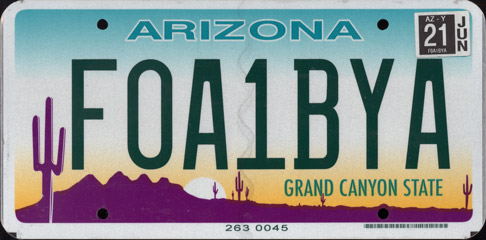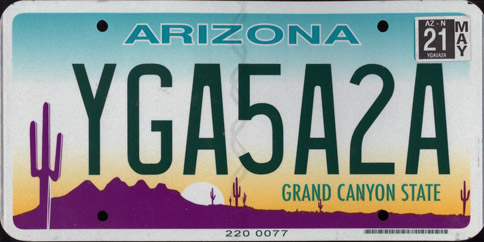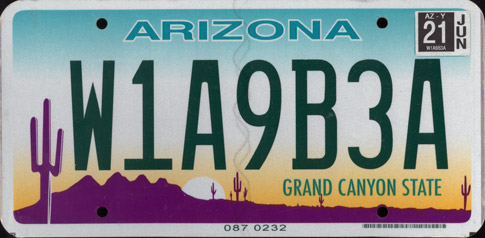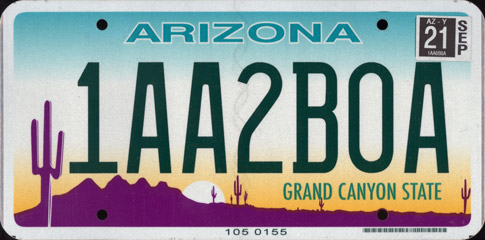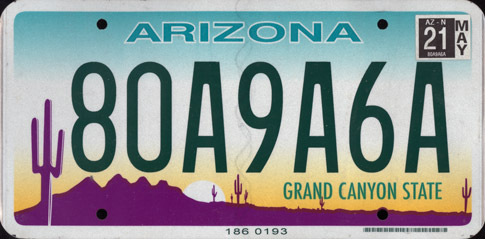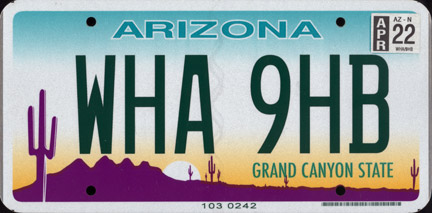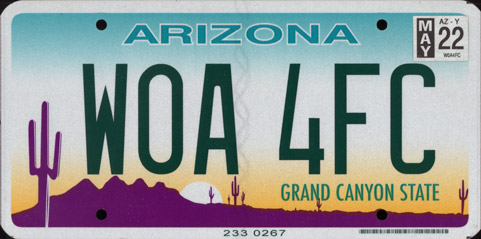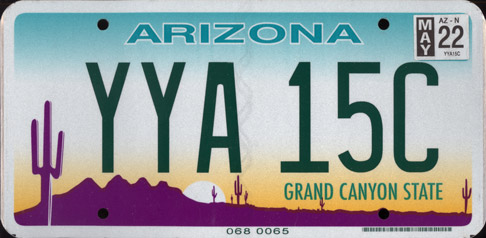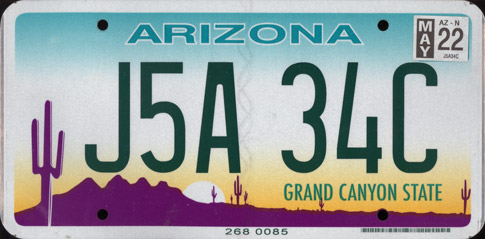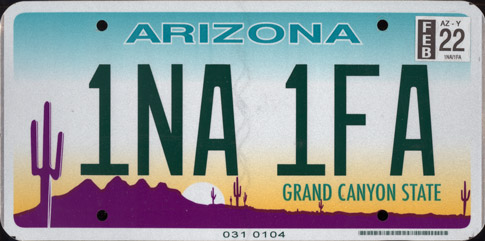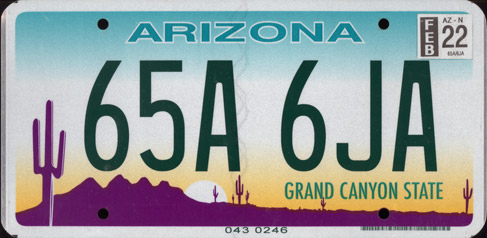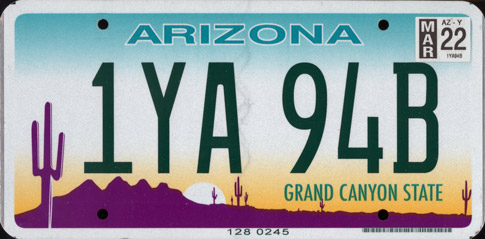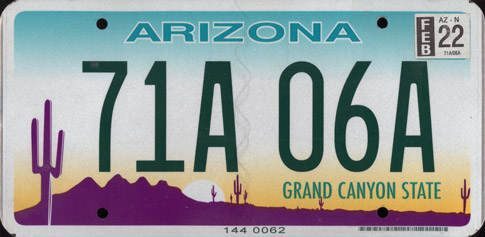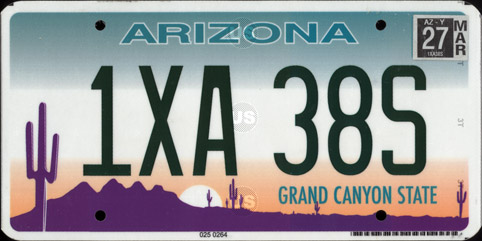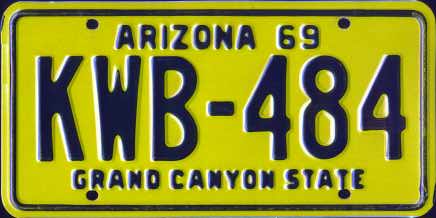 |
Arizona 1969 passenger issue. Arizona issued this plate to all motorists at the end of 1968 and it remained in use through the end of 1972. Plates were valid without stickers in 1969. "Grand Canyon State" was first used on Arizona plates in 1940 and remains today. |
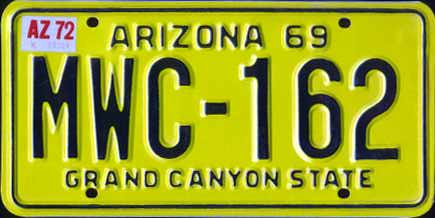 |
Arizona 1972 passenger issue (1969 base). Same issue as above, with 1972 validation sticker. This plate also features wider dies for the state name and slogan. |
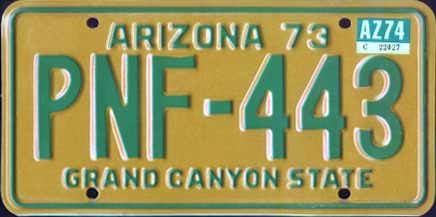 |
Arizona 1974 passenger issue (1973 base). This baseplate was issued at the end of 1972 and was issued through 1980. The 1973 baseplate remained valid with stickers through 1990. Staggered monthly registration and month stickers were introduced in 1975. |
 |
Arizona 1978 passenger issue (1973 base). Continuation of the 1973 base. Starting with some late-period plates on this base, motorists began placing the year sticker at the bottom right of the plate, rather than the top right. This placement continued onto the next baseplate as well. |
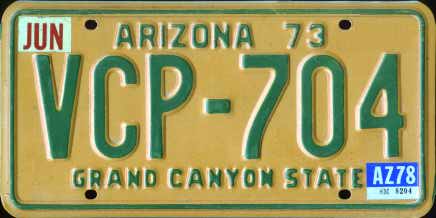 |
Arizona 1978 passenger issue (1973 base). Another 1978 issue, this plate uses a narrower die variation for the "Arizona" and "Grand Canyon State" as compared to the larger dies used on the plates above. Both these die sizes were used in the production of these plates, with the smaller ones on this plate being the rarer of the two, I believe. |
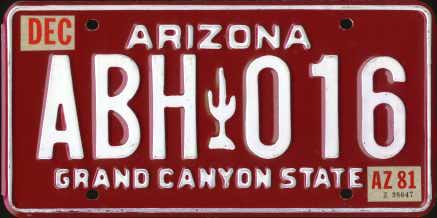 |
Arizona 1981 passenger issue. The maroon Cactus base was first issued in 1980 and was issued to new registrants only, with previous 1973-base plates remaining in use until 1990. These plates featured a cactus divider between the letters and numbers. Arizona stopped issuing these plates in 1997, although existing plates remain valid with stickers. These plates were issued in pairs initially, into the ETx series, then singly thereafter. Cars with front plates can still be seen on the road. There are several small die variations on this plate, with this one being the first type with a large size "Arizona" and wide slogan, slightly offset to the left to leave room for the sticker. |
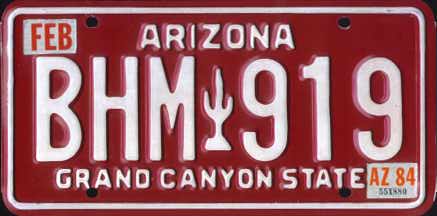 |
Arizona 1984 passenger issue. Another variation on this base, this plate features a smaller die for the state name (same as the second variety used on the 1973 base, as seen on the 1981 plate above). The slogan die on this plate is identical to the 1982 plate above, also offset to allow room for the year sticker. This variation appeared randomly throughout the "B" series. |
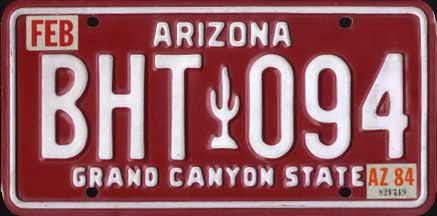 |
Arizona 1984 passenger issue. Third variant of the state name die, this issue used an even narrower "Arizona" die, like the smaller of the ones on the '73 base. These are the rarest of the state name die issues, observed only in the "BHT" and "BHY" series |
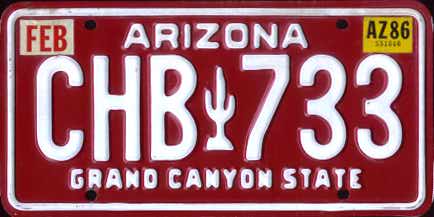 |
Arizona 1986 passenger issue. Another mix-and-match job with the dies, this variation uses the large state name die (like the 1981 plate above) mated with an older, narrow die for the slogan (seen on the 1969 and 1975 plates previously on this page). This variation appeared randomly throughout the late "B" through the late "D" series of plates. There are supposedly a couple different variations of the outside border die through this stretch as well, but I think that's where I get off this particular train. |
 |
Arizona 1989 passenger issue. This was the prevalent type on this base, featuring the standard, thinner border, full-size "Arizona" die and full-size, centered slogan at the bottom. This die arrangement was seen exclusively from the mid "E" series to the end of the plate's issuance in 1997, somewhere in the "N"s. |
 |
Arizona 1997 passenger issue. Late period Cactus plate. For some reason, later in the series, motorists began placing the year sticker in the top right of the plate instead of the bottom right as had previously been the norm. Otherwise identical to the 1989 plate above. |
 |
Arizona 1998 passenger issue. This new graphic base is Arizona's current issue. It features a colorful desertscape, cacti and mountains. This plate was designed by ALPCA member Wally Punzmann (#6155) and was named ALPCA Plate of the Year in 1997. This remains the current Arizona base today. |
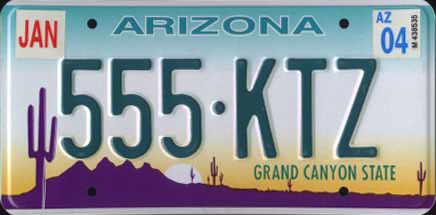 |
Arizona 2004 passenger issue. Continuation of the base above, this one features larger validation stickers. The size of the year sticker was increased starting with 2001 expirations, and the larger month sticker seems to be a more recent development. These stickers work OK on the new plate, but are kind of a mess on the older, still-valid maroon plates, since they don't fit in any of the corners of the plate without overlapping the numbers. Minor issue, I mostly just included this one since I hadn't changed this page in a while. |
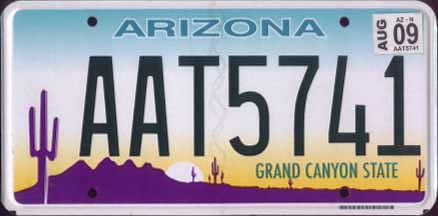 |
Arizona 2009 passenger issue. Upon reaching the end of the ZZZ series in early 2008, Arizona switched to a seven-digit ABC1234 format. Corresponding with the format change was a switch to 3M's digital flat plates. These plates use one of the better-looking custom serial fonts developed by 3M, which may be unique to Arizona plates. Most 2009 issues use new single month/year stickers with the plate number printed on the sticker.
|
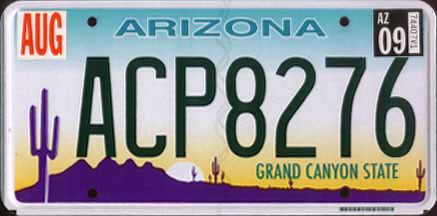 |
Arizona 2009 passenger issue. Continuation of the seven-digit base. To improve visibility of the serial when used with a license plate frame, the serial was moved slightly to the left starting around the ABM series. The move was very slight, approximately 1/8", and most noticeable when comparing the position of the 'A' relative to the mountain graphic. The serial has since been shifted a couple more times as the state fine-tunes the seven-digit layout. This plate also features a 2009 expiration using the old-style separate month and year stickers.
|
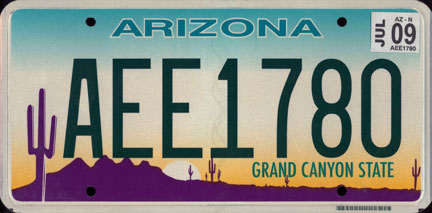 |
Arizona 2009 passenger issue. More fine-tuning to the serial placement on the plate occurred near the end of the ADx series, including a rare variant in the ADY series with the serial more or less centered on the plate. The state seems to have finally settled on this placement, with the serial offset a bit further from the right side of the plate than on the plate above, again most obvious when looking at the position of the "A" relative to the mountains and cactus. This appears to have been an acceptable placement as the serial has stayed static in this location since.
|
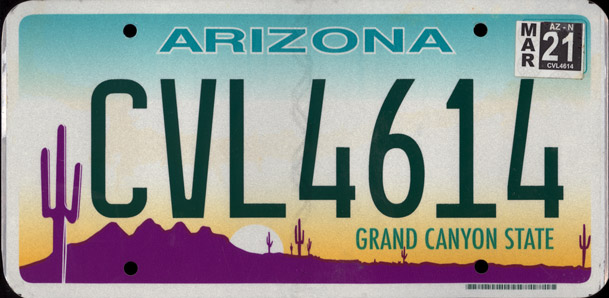 |
Arizona 2021 passenger issue. A change was made to Arizona plates near the end of the C series in early 2020 which eliminated any beveled edges and resulted in a completely flat plate. The C series was discontinued from passenger issuance shortly thereafter but has continued to be issued to rental/fleet vehicles throughout the ensuing madness (see next.)
|
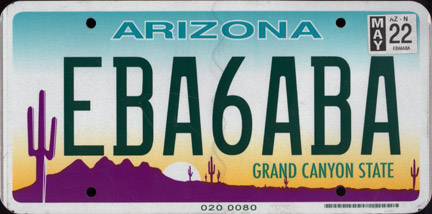 |
Arizona 2021 passenger issue. In April, 2020, Arizona lost its collective plate-issuing mind and abandoned the ABC1234 format (which had reached the late C series at the time) in favor of...this. The sequences on these plates were allegedly random, but a vigilant team of elite plate nerds managed to decode them.
Basically, the center character is always a number, all others could be a letter or number, although the format was discontinued before characters 3, 5 or 7 progressed into numbers. The series started at AAA0AAA, he center number would progress 0-9 on sequential plates (AAA0AAA, AAA1AAA), then the other characters would progress A-Z then 0-9 in the following sequence: position 2, 6, 1 and 5. (3 and 7 never progressed past A while this system was in use, so it's unknown which would've flipped first.)
Decoding via this system, the plates shown here map out to AAA-EBB6, AAA-0E79 and AAA-9GK7. Just that easy...
The different possibilities of letters and numbers in various positions resulted in eight different serial formats in this system (while it lasted). Good luck taking any of these down in a hit-and-run situation. The confusing nature of the system and the likely realization that the state really didn't need a system that allowed for over 10 billion possible combinations resulted in the discontinuation of this seven-digit system after about nine months (see next).
I'd recommend consulting the February, 2021 issue of the ALPCA newsletter for much more comprehensive information on this nut-job system. Meanwhile, if you want to check out all the possible permutations of this format, see below.
|
 |
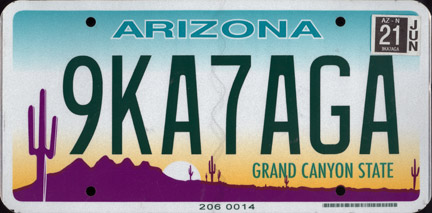 |





















